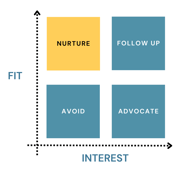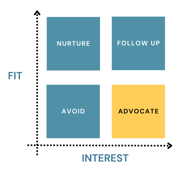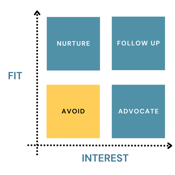Both sales and marketing departments have a vested interest in lead qualification. However, creating a lead qualification checklist that both departments agree upon can cause major headaches for your managers and senior leadership team. By clearly defining your Marketing Qualified Leads and implementing a data-informed lead scoring system, you'll see a measurable improvement in your company's conversion rates and time-to-conversion metrics. In this article, we'll walk you through how to set up your lead qualification checklist from start to finish.
1. Start With Your MQL Definition
The first item to complete for your lead qualification checklist is arguable the most important and demand: Define your company's Marketing Qualified Lead (MQL).
An MQL is one that has a high lead score. In tools like HubSpot, lead scores are determined based on the number and type of interactions a visitor or prospect has with your trackable marketing content before they become a customer.
Every company's definition of an MQL will vary. Still, it should reflect a combination of traits and actions that indicate a lead is 1) a good fit for your company and 2) ready to talk to a salesperson.
Aspects of Lead Qualification
 Is the lead a good fit?
Is the lead a good fit?
Your company might target financial services companies with 5,000 or more employees, or small service businesses with fewer than 100 employees. Or, you may be only interested in manufacturing companies of any size. Within a category, you also might identify individual lead profiles, such as title or job description and role in the decision-making process – e.g., economic buyer, end user, influencer.
How closely a lead aligns with your ideal customer profile will determine whether and when you hand it over to the sales team.
Is the lead interested?
A lead’s activity can reveal how close they are to a buying decision. For example, if a lead has only visited your website once or has just begun following you on LinkedIn, they may be aware of your company but are not particularly engaged. But a lead that requests a demo or views pricing information is showing a lot more interest.
Where a lead falls within the four quadrants of the above matrix dictates the next step your marketing or sales team should take.
2. Lead Qualification by Matrix Quadrant
.png?width=175&height=175&name=1%20(2).png) Good Fit, High Interest
Good Fit, High Interest
Leads in the upper right quadrant are a good fit for your company and engage heavily with your marketing. These hot leads require immediate follow-up from your sales team – usually in less than 24 hours.
 Good Fit, Low Interest
Good Fit, Low Interest
Leads in the upper left quadrant are a good fit for your company but aren’t showing a great deal of interest yet. Perhaps they’ve only signed up for an email newsletter or downloaded one piece of educational content. These are leads that the marketing team needs to continue nurturing.
 High Interest, Poor Fit
High Interest, Poor Fit
Leads in the lower right don’t necessarily fit your ideal customer profile but do engage with your brand. They might have subscribed to your blog and email newsletter, downloaded your ebooks, and attended your webinars. It’s worth having a sales rep do a low-cost follow-up with these fans to see if there’s an easy sale to make from a non-traditional customer.
Sometimes, leads that don’t seem like a fit have a good reason to buy your product. They can also turn into great evangelists for your products or services, thus providing you with indirect support as non-customers. That’s why you can’t automate the entire sales and marketing process. At some point, a good marketer or sales rep can spot an opportunity that your systems might overlook.
 Low Interest, Poor Fit
Low Interest, Poor Fit
Leads in the lower left quadrant aren’t a good fit for your company and don’t show much interest in your marketing content. More than likely, focusing on them is not a great use of anyone’s time. Don’t be afraid to remove them from your communication stream (i.e., mark them as non-marketing contacts if using HubSpot.). By having a clean list of more engaged subscribers, your email and social efforts will show better results.
3. Develop Your Lead Scoring System
Using this matrix as your guide, develop an MQL definition based on the combination of fit and interest that’s right for your company. Some marketers may focus more on fit because they have a tightly defined market; others may have a broad customer base and focus more on interest level. That decision depends on your business model.
MQL definitions in those two cases might look like this:
- A contact with the right title or role that has filled out a landing page form and works at a financial services company in the United States with more than 5,000 employees.
- A contact with the right title or role at any U.S.-based company that has requested a product demonstration from a sales rep.
Whichever approach you choose, base your definitions on data, not gut instinct. Even experienced marketers and salespeople can be way off base in their assumptions about what makes a good lead.
A lead scoring or lead grading program that relies on data from your closed-loop analysis – like HubSpot – can help you determine the importance of different activities and automate your contact progression from lead to MQL status.
4. Put Your Lead Scoring System in Action
Examine Behavioral History
Examine the activity history of recent customers and analyze how many actions they took before becoming a customer – i.e., the number of page views or conversions such as downloading a white paper or registering for a webinar, etc.
Find Patterns
Look for patterns that indicate a lead’s likelihood of closing. For example, if a lead that downloads ten pieces of content from your website or visits your site more than 15 times in one month is more likely to close, you can incorporate those frequency measures in your MQL definition.
Read The Value of QR Codes in Lead Generation & Attribution
List Activities
Also, list all the activities a lead can take before becoming a customer and analyze the close rate for each.
For example, to determine the close rate for a webinar, look at all customers that watched a webinar, then divide that number by the total number of leads that originally registered for the webinar. That gives you the close rate for leads from that particular event.
Calculate Close Rates
Using the close rates for individual actions, calculate the average close rate for all your marketing activities. Then, look for actions that have a significantly higher close rate. For example, if your average close rate is around 1%, you might find a handful of actions with a 3%-5% close rate.
Add these top-closing events to your definition of an MQL. Any lead that engages in at least one of these activities and is a good fit for your company would be considered an MQL. Also, use those close rates to decide what score to give to different activities in your lead scoring or lead grading system.
Creating your own lead qualification checklist can seem daunting at first. By using the Fit & Interest Matrix, developing a lead scoring system, and using actionable data to inform your lead scoring, your team will efficiently move leads from marketing to sales and increase conversion rates.
If you’d like help creating your closed-loop analytics or setting up an automated lead scoring system for your company, reach out to our team of experts! We’re ready to help you grow your business.


